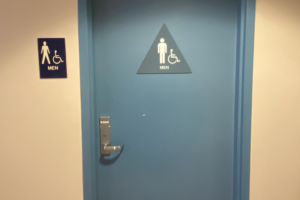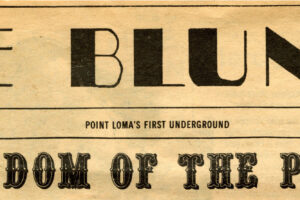A long, two-lane highway was blasted with strong headwinds as Erin Anderson, a 2014 alumna, cycled across random broken asphalt in central Wyoming. Anderson was in the middle of a 4,300-mile journey.
About two years ago, Anderson’s mom, Miki Stuebe, asked Anderson to cycle cross-country with her.
“I was determined to make the trip even if I had to do it solo,” said Stuebe. “I’ve wanted to cycle cross-country for so long that I no longer remember for sure what the original inspiration was,” says Stuebe. “But when I told Erin that I wanted to cycle cross-country, she blurted, ‘I’ll go!’ almost before I’d finished speaking. Of course, I was thrilled, so then it was a matter of making preparations and biding our time until we were both available.”
Anderson has a similar adventurous spirit.
“I look up to her a lot as a woman who takes full advantage of life and has done some really cool things in her time,” said Anderson. “She told me about the idea, and I jumped on board. Then we started stirring the pot, deciding where and how and when we were going to do it.”
Stuebe has cycled for over 30 years and pulled Anderson and her siblings around in a bike trailer as kids. Even though bikes have always been a part of Anderson’s life, she has only biked continually the past few years.
“I grew up riding bikes for fun and to get around, but it was nothing serious—it still isn’t serious,” said Anderson. “Bikes are purely fun for me. It wasn’t until I got to San Diego where I found that getting around on bike in the city and to/from campus was easier than getting around by car … I have never been competitive about it—I just think it’s a great way to get around, and it’s fun to go fast without a barrier between you and the air.”
Anderson and Stuebe faced some challenges from biking around San Diego to riding across the country. The hardest part was getting through windy days.
“It can really get to your head when you’re in the middle of nowhere Wyoming or Kansas, trying to get through a dry, hot wasteland to the next sliver of civilization and a 20 mph headwind is making you work three times as hard to get there,” said Anderson.
As Anderson and Stuebe biked 80 miles in southern Wyoming and down a two-lane highway they faced some close calls.
“We were nearly being sideswiped by oversized-semi loads every two minutes and had a shoulder made of rumble-strip and broken asphalt to ride on,” said Anderson. “My mom and I are both pretty mentally tough, but it’s hard to keep positive in a situation like that. So you just have to put your head down and get through it.”
They started their journey after Anderson graduated in 2014, cycling from Oregon to Virginia in 90 days.
The two started their journey in May, but didn’t finish until October because they took a six week break from riding, so that Anderson could take field ecology classes at a biological station in northwest Montana in June and July. Anderson was an environmental science major at PLNU.
“It was fun to show up to field classes and know that I rode 1,500 miles to get to them,” said Anderson.
Their original route spanned 10 states and 4,300 miles.
“We ended up crossing into 12 states and riding 4700 miles. Our route depended a lot on who we wanted to see along the way—we both have friends across the country. So we went to places like Jackson Hole, Wyoming, and Bloomington, Indiana that weren’t on that route but were a priority for us.”
The pair stayed in fire stations, churches, city parks, hostels, friends-of-friends homes, stranger’s houses, attics, basements and a couple of motels when they had no camping options or needed a shower.
Two years was just the right amount of time for them to find gear and sturdy bikes for their journey. The two learned to be resourceful and to live minimally. The gear they brought was pretty basic and as lightweight as possible: sleeping bags and pads, tent, cook kit, bike parts, spare tubes, clothes and toiletries, warm clothes and rain gear.
“I learned how little I need in the way of clothes and possessions,“ said Stuebe.
Anderson had done a lot of backpacking before, so she knew what she could get away with.
“I always carried a book and a journal, and a set of pens, but the hardest part of packing was choosing what clothes to bring for times off the bike,” said Anderson. “One pair of pants, two shirts, one pair of shorts. For three months. Talk about pressure. My closet was essentially a tiny backpack, but it was fantastic. I never had to think about what to wear. Now that I’m back to having a closet I feel like I have way too much stuff.”
The long days made the pair thankful for traveling together.
“We had each other for company, but there were stretches where we wouldn’t have a real conversation with anyone else for days,” said Anderson. “In some of the country we rode through, there just isn’t anyone out there. It made me grateful looking back at the constant companionship I had at Point Loma. It got lonely out there. I don’t know if I would have been able to do it on my own.”
Riding through unknown places and sometimes having to ask for a place to stay at night forced Anderson to open up and be vulnerable.
“I learned [Anderson’s] much more mature and wiser in many ways than I was at her age,” said Stuebe.
Anderson realized through this trip that she had to be resourceful. The ride challenged her wit and her perception, but she trusted her intuition.
“You have to be able to laugh at everything, and not get discouraged riding for a week on Kansas’s roads with three turns within 400 miles. You have to be able to talk to anyone, from a toothless local in southern Missouri to a millionaire Colorado banker. It was a wild sort of freedom that is hard to put into words, I guess. But the kindness and willingness of strangers is there. If you ever lose faith in humanity, just get on a bike.”







